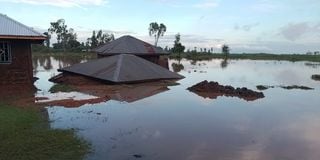Effect rainwater harvesting, storage policies, strategies

Houses submerged in flood waters in Kobala, Rachuonyo North sub-County on April 11,2024.
The torrential rains and raging floods ravaging several counties should be a wake-up call to rethink prevention, mitigation and responses to stop the deaths and injuries and reduce infrastructure damage, loss of livelihoods and disruption of socioeconomic activities.
The downpours have also exposed the vulnerability of urban businesses, transport and housing. The situation is worsened by poor urban planning and encroachment on riparian lands and wetlands.
With more rains expected in the coming days, we could be exposed to other effects of floods, like waterborne disease outbreaks. It is time the national and county governments and other stakeholders redefined the preventive and mitigation measures.
Despite their destructive nature, the devastating torrential rains could be beneficial were appropriate measures put in place to capture and store the rainwater in reservoirs. But can our dams handle the deluge when it rains heavily for days? Isn’t it time to establish man-made lakes along major basins to capture the enhanced runoff? Is a Kariba Dam, or even an Aswan High Dam, possible here?
It is laudable that rainwater harvesting and storage policy, strategy and regulations, the national irrigation policy and other related policies that have incorporated provisions on rainwater harvesting have been developed in the past decade to respond to increasing water demands.
But there is a need to strategically invest in their effective implementation, to not only meet the rising demand for water but also ensure water security for agricultural production, power generation and other water needs.
Rainwater harvesting is seen as inevitable as over 80 per cent of Kenya is classified as arid and semi-arid lands (ASALs). Two-thirds of the country receives less than 500mm of rainfall per year and 79 per cent less than 700mm while only 11 per cent gets more than 1,000mm, the National Water Harvesting and Storage Strategy (2020-2025) shows.
Due to uneven distribution of freshwater resources, ASAL counties perennially face severe water shortages, especially during prolonged droughts. Yet rainwater harvesting and other such initiatives could alleviate water challenges in the ASALs.
The Fourth Medium-Term Plan (2023-2027) of the Kenya Vision 2030, however, contains plans to construct 300 climate-proof underground reservoirs in the ASALs, each with the capacity to store a million cubic metres of water for three seasons.
Rainwater flows across counties; harvesting and storage strategies need cooperation of upstream and downstream counties. Similarly, some rivers cross international borders, hence the need for transboundary cooperation in the management of water resources. Rainwater harvesting and storage initiatives may need inter-basin cooperation.
Proactive measures are critical to minimise the effects of torrential rains and floods on households, croplands, infrastructure and socio-economic activities. Effective implementation of rainwater harvesting and storage policies and strategies needs political goodwill from the leadership of the two levels of government.
- Mr Odhiambo is a policy analyst. [email protected].





